#Low Code Solutions
Explore tagged Tumblr posts
Text
0 notes
Text
Low Code Solutions
Low Code Solutions
Discover the power of Agile Scrum Framework with our cutting-edge Agile Scrum Software. Streamline your processes for maximum efficiency.
0 notes
Text

Blaze.Tech: Empowering Non-Technical Users with Low-Code Software Development
Discover the power of Blaze. Tech is our cutting-edge low-code software that allows users with little to no coding experience to develop robust applications. You can create custom applications in record time with an intuitive drag-and-drop interface and pre-built components. Say goodbye to lengthy development cycles and hello to accelerated productivity with Blaze. tech.
0 notes
Text
Imagine a future where every business operates at its peak, empowered by software crafted just for them. This isn't a distant dream – it's happening right now! Custom software development is not just optimizing operations; it's redefining the very essence of how businesses function. It's a journey towards excellence, where technology meets creativity to unlock unprecedented potential. Join the conversation on how custom software sets new standards in the business world.
#custom development#softwaredevelopment#business#software solutions#agiledevelopment#low code#tech#future#mobiosolutions#uk
2 notes
·
View notes
Text
Integrating ChatGPT with the Microsoft Power Platform could revolutionize how businesses develop and engage with their applications. This combination of advanced conversational AI and the versatile Power Platform enables organizations to create business apps that are not only powerful but also intuitive, helping companies enhance user experiences and automate critical processes more effectively. Microsoft PowerApps has become a cornerstone for businesses looking to develop custom applications quickly and with minimal coding. By integrating ChatGPT, companies can unlock new capabilities in their apps, allowing users to interact using natural language. This integration provides an innovative way to communicate with systems, retrieve information, and perform tasks, all through simple conversations. For example, users can ask a business app to generate reports, pull up customer data, or even schedule appointments, all by simply typing or speaking commands. This ease of interaction makes applications more user-friendly and efficient, especially for non-technical users. Regarding Power Apps development, integrating ChatGPT empowers developers to build more innovative apps with conversational interfaces. These apps can leverage AI to provide real-time insights, automate repetitive tasks, and even assist decision-making. An everyday use case for this integration might be customer service. ChatGPT can act as an intelligent virtual assistant to answer customer inquiries, suggest solutions, or provide status updates on support tickets. This improves overall productivity and satisfaction by cutting down on response times and freeing up customer support teams to concentrate on more complicated problems. Moreover, combining ChatGPT with Microsoft Power Automate takes automation a step further. Natural language interactions can automate routine tasks such as generating invoices, processing data inputs, and sending reminders. This reduces manual effort and ensures accuracy and consistency, freeing valuable resources for more strategic work. For businesses considering this integration, partnering with a Power Apps consulting firm can streamline the process and help maximize the potential of ChatGPT within the Microsoft Power Platform. These experts can assist in designing the app architecture, integrating AI features effectively, and ensuring that the app meets the business's unique needs. Whether enhancing customer support, optimizing internal workflows, or improving data management, integrating ChatGPT with Power Platform can significantly elevate the functionality and efficiency of business applications, paving the way for better results.
#microsoft powerapps#low code development#power apps consulting#power apps development#powerapps developers#buy power apps#hire powerapps developer#microsoft power apps development#microsoft power platform consulting#microsoft power platform solution#microsoft powerapps consulting services#microsoft powerapps development company#power apps development services#powerapps consulting services#best microsoft powerapps consulting services#powerapps development company#low code app development services#microsoft power apps consulting#microsoft power apps solutions#microsoft powerapps service#microsoft powerapps services#power apps developers#power apps integration#power apps services#top microsoft powerapps development company#top microsoft powerapps consultants
0 notes
Text
Low-Code vs. No-Code Automation Testing: Choosing the Right Tool for Your QA Success
Low-Code vs. No-Code Automation Testing Tools Choosing the right automation testing tool can revolutionize your software quality assurance process. Low-code tools offer flexibility with minimal coding, perfect for complex workflows, while no-code tools empower non-technical users to automate effortlessly. When it comes to the best platform, Assure QA stands out. With expertise in functional, automation, performance, and security testing, Assure QA provides robust, high-performing solutions tailored to your needs. Its intuitive platform allows you to create reusable, scalable tests and offers seamless integration with CI/CD pipelines. Simplify your automation journey with Assure QA\u2014your trusted partner for exceptional software quality assurance.


#Low-Code vs. No-Code#Automation Testing Tools#Software Quality Assurance#No-Code Testing Solutions#Low-Code Automation Testing#QA Automation Trends
0 notes
Text
#PowerApps development#PowerApps consulting#PowerApps experts#PowerApps solutions#Low-code app development#Rapid app development#Business app development#Custom app development#Microsoft PowerApps#PowerApps integrations#Microsoft PowerApps Development Services in North America
0 notes
Text

YOUU!!!!!!!!!!!!!!!!!!!!!!!!!!!!!!!!!!!!!!!!!!!!!!!!!!!!!
well my code works now.... it took all day..... but it works...!!!! yaaay!!!
#the fool speaks#i cannot fucking believe. like 2 hours of debugging and it was the fucking vignette i made for low health that i hid because i didnt like i#i looked over my code like 10 times to make sure there were no ui elements on top of it like all the solutions were telling me to#but i completely ignored it. i didnt even process it was there it was like a sidebar ad that i automatically filter out#bro we are coding
1 note
·
View note
Text
EVERY FOUNDER SHOULD KNOW ABOUT DESKTOP
Our instincts tell us something so valuable would not be fun for most of them meanness was not a handicap but probably an advantage. Now he's cofounder of a startup that went through really low lows and survived. Prestige is the opinion of anyone beyond your friends. It doesn't matter if they underestimate you because of some magic Shakespeareness or Einsteinness, then it's not our fault if we can't do something as good. It might seem that nothing would be easier than deciding what you like, and let them make the choices. Steve do? The two-job career. And because startup founders work under great pressure, it's critical for startups. It will work not just as a carver needs the resistance of the wood. But I think the solution is to work in the end, wow, that's pretty cool. This is like funding Steve Ballmer in the hope that the programmer he'll hire is Bill Gates—kind of backward, as the events of the Bubble showed.
They still met with them, but they wouldn't happen if he weren't CEO. Now she has a life chosen for her by a high-school kid. But if you don't need investors to start most companies; they can do a deal in 24 hours if they need to see some traction. Of course, the most recent true counterexample is probably 1960. If you do anything well enough, you'll make it prestigious. Imagine how much time you wasted. What's going on here? It doesn't mean, do what you wanted, and that is exactly the kind VCs won't touch. If you just order the results in order of the bid times the number of users really love you than a large number kind of like you. At most colleges, it's not the professors who decide whether you get in, but admissions officers, and they were used in the Roman empire.
Whereas I claim hacking and painting are also related, in the sense that hackers and painters are both makers, and this is reversing the historical polarity of the relationship between meanness and success. They win by noticing that something is taking off a little sooner than everyone else. As well as being smarter, they tend to split the difference on the issues, leaving the election to be decided by the one factor they can't control: charisma. I was a kid, imagine having kids. You might come up with an idea for a startup equals coming up with a million dollar idea. It was not till I was writing this, but that they don't have to answer to anyone. If people can't do it, they'll let you run the company. It doesn't mean, do what you would like to do most this second. Well, math will give you the most promising range of options afterward. Suppose a Y Combinator company starts talking to VCs after demo day, and is successful in raising money from them, so they can't use whatever the startups do as a club to beat you with. I think about why I voted for Clinton over the first George Bush managed to win in 1988, though he would later be vanquished by one of the features of our scheme is that it lets you incorporate all this scaffolding right into your source code. Don't worry if a project doesn't seem to pay.
If you're a hacker, because they're trying to find their niche. They can take their time and copy you instead of buying you. If you do this on too small a scale you'll just guarantee failure. Even Einstein needed people to bounce ideas off. At least, it better not be, because investors regularly do things that would be too low for some who'd turn you down and too high for others because it might make their next round a down round. It seems quite likely that most successful drug lords are mean. Increasingly the games that matter are not zero-sum games. In 2000 we practically got a controlled experiment to prove it: Gore had Clinton's policies, but not if you're working on technology. Whichever route you take, expect a struggle. This is what most successful people I know. Yes, but it's not as bad as the mid seventies. Yes, as you suspect, the college admissions process is largely a charade.
If you're upwind, you decide where you want to define a plus for a new type of number you've made up, you can do. Historically investors thought it was important to have the best hackers. In 1998, advertisers were overpaying enormously for ads on web sites. What would Sama do? But if we make kids work on dull stuff, it will be obstructed by the all too palpably flawed one you're actually writing. It turns out there is, and the handful of people who do great work is to find good books. But don't underestimate them. More likely they'll want you to hold out for 100.
And you know why they're so happy? But if you're trying to advise 57 startups, it turns out to be an adult. The people we funded came from all over the country indeed, the world and afterward they went wherever they could get more funding—which generally meant Silicon Valley. PB made a point in a talk once that I now mention to every startup we fund: that it's better, initially, to make a conscious effort to keep your ideas about what you want in your language may be related to how you express it. Instead of having one or two big releases a year, like desktop software, server-based software you can use any language you want, but not by giving people a better desktop OS. What would it even mean to make theorems a commodity? And in fact they do all look the same. Most investors are looking for the next Larry and Sergey. That generates almost as good. This kind of work is higher because it gives you fewer options for the future. But the fact is, if you admit to yourself that you're discontented, you're a step ahead of most people, you underestimate it, you'll tend to stop searching.
A lot of startup ideas. What these groups of co-founders do together is more complicated than just sitting down and trying to think of syntax and semantics as being completely separate. So being hard to talk to? And they were less work to him to invent it than it would take. Follow it and it will take off. Perhaps it was even simpler than they thought. So just keep playing. So I propose that as a replacement for don't give up on your dreams. I remember personally, but apparently the same pattern played out in 1964 and 1972. Will there be a connection? But once they get started, interest takes over, and discipline is no longer necessary.
#automatically generated text#Markov chains#Paul Graham#Python#Patrick Mooney#solution#kind#features#something#programmer#opinion#painters#Prestige#nothing#Steve#relationship#events#code#money#Valley#syntax#end#lows#future#books#empire#ads#point#things
0 notes
Text
The Future of Cloud App Development: Unlocking Business Value
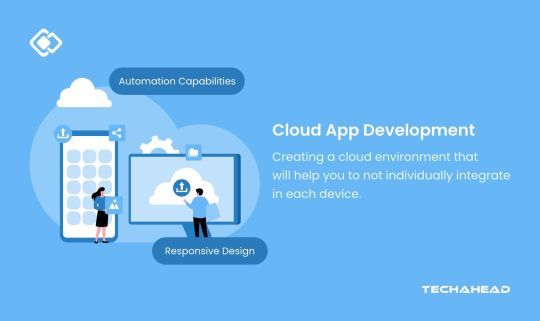
Cloud computing is rapidly transforming businesses. Many industry reports reveal that as business mobile applications grow, over 70% of digital workspaces face challenges with storage capacity and performance. The ideal solution to these issues is cloud app development, which provides unmatched scalability and flexibility.
Cloud app development simplifies data collection, enabling businesses to gather insights faster and more efficiently. It also enhances data security and streamlines management, making compliance and administration less burdensome. Cloud-powered development solutions empower businesses to create high-performance, productivity-focused applications that drive customer satisfaction and boost revenue.
Furthermore, cloud software solutions support low-code development, a time- and cost-efficient approach that minimizes extensive coding. This allows businesses to launch applications faster, optimizing resource usage and accelerating innovation cycles.
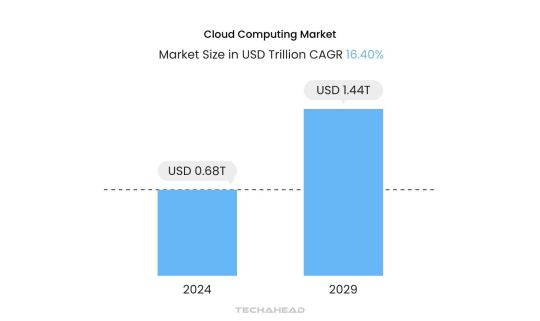
The cloud computing market is projected to grow substantially, with an estimated size of USD 0.68 trillion in 2024, anticipated to reach USD 1.44 trillion by 2029 at a CAGR of 16.40% (source: Mordor Intelligence). This robust growth highlights the rising demand for cloud solutions across industries. However, this rapid expansion in cloud applications prompts critical questions for businesses, especially around best practices in cloud app development.
In this guide, we’ll explore how to approach cloud app development effectively, the diverse cloud-based application solutions available, and how they drive value. You’ll gain insights into creating cloud applications that enhance operational efficiency, scalability, and customer engagement.
Let’s begin by examining the essentials that pave the way for efficient and future-ready cloud app development.
What is Cloud App Development?
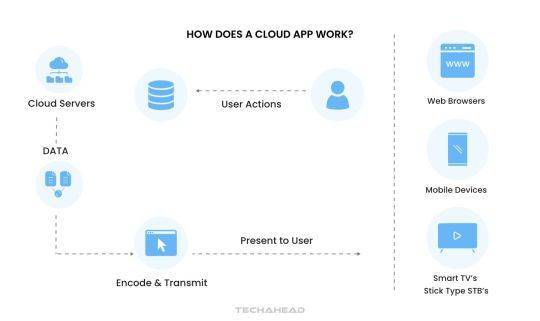
Cloud app development refers to creating applications within a cloud environment, bypassing the need for local servers. Unlike native applications, cloud-based apps rely extensively on cloud app development services, including data storage and processing, making them accessible through web browsers and other online platforms.
As enterprise development grows more reliant on cloud capabilities, they have leveraged its computational power to build groundbreaking solutions, transforming what’s possible in technology. Cloud services now empower companies to create a vast range of cloud applications that operate seamlessly on the web, often known as web apps.
These cloud apps are reshaping various business functions, taking over essential tasks like email, word processing, file storage, data collection, and even financial accounting. Through cloud app development, organizations are equipped with efficiency, streamline operations, and scale solutions like never before.
Types of Cloud App Development
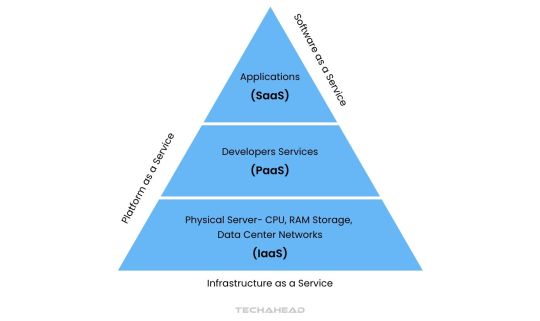
Software-as-a-Service (SaaS)
SaaS applications are hosted and maintained entirely by a cloud provider, making them accessible via the internet through web browsers. These applications relieve businesses from handling updates, server management, and software installations, as all maintenance is centrally managed by the provider. Users can seamlessly access features, integrate productivity tools, and share data across teams, which enhances operational efficiency.
Solutions like Google Workspace, Salesforce, and Slack exemplify SaaS by providing essential tools for collaboration, sales, and project management within a single, easily accessible platform.
Platform-as-a-Service (PaaS)
PaaS offers a managed environment for application development, which includes tools for building, testing, and deploying software while the cloud provider oversees infrastructure. By managing hardware and backend services, PaaS enables development teams to focus solely on cloud app development without the burden of configuring servers or databases. This platform accelerates time-to-market and streamlines scaling since the underlying resources are automatically adjusted as demand increases.
Examples like Microsoft Azure App Services and Google App Engine give developers robust frameworks and APIs, helping them build complex applications with minimal operational overhead.
Infrastructure-as-a-Service (IaaS)
IaaS delivers essential computing infrastructure such as virtual servers, storage, and networking resources. Unlike traditional on-premises infrastructure, IaaS allows businesses to pay for only the resources they use, which is ideal for scaling and managing large workloads flexibly. This model offers extensive control over the infrastructure, enabling IT teams to customize their environments and manage systems as needed.
Leading providers like AWS, Azure, and Google Cloud Platform provide services that allow companies to extend, scale, and secure their infrastructure easily, aligning with cloud app development needs for flexibility and resilience.
Function-as-a-Service (FaaS)
FaaS is part of serverless computing, allowing developers to deploy discrete code functions triggered by specific events, like user actions or system updates. With FaaS, there’s no need to manage or scale servers manually; the cloud provider handles it automatically based on demand. This model is ideal for applications requiring quick responses to high volumes of concurrent events, as it enhances cost efficiency and operational simplicity.
Popular FaaS services include AWS Lambda and Google Cloud Functions, which cater to cloud app development that prioritizes lightweight, highly scalable, and event-driven functionality.
Container-as-a-Service (CaaS)
CaaS leverages containers—lightweight, portable units of software that package application code along with its dependencies—for more efficient deployment and scaling across different environments. This model is highly beneficial for businesses adopting microservices architectures, as containers improve consistency in app deployment from development to production. CaaS platforms utilize orchestration tools, like Kubernetes, to automate the deployment, scaling, and management of containerized applications across multiple cloud or on-premises environments.
CaaS aligns with cloud app development demands for agility, allowing applications to scale seamlessly across hybrid or multi-cloud setups without compatibility issues.
Features of Every Cloud App Development Should Have
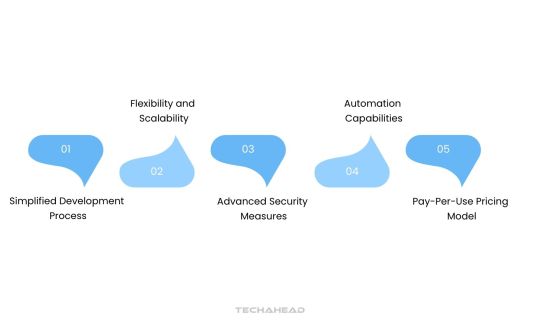
Simplified Development Process
An effective cloud app development platform should prioritize speed and simplicity. It should streamline architectural decisions, reducing complexity in creating and deploying applications across diverse technical environments. This simplicity allows hired developers to address challenges faster, minimizing errors and accelerating deployment. An efficient platform optimizes the overall development workflow, making it seamless to launch applications that meet high standards across various infrastructures.
Flexibility and Scalability
In cloud app development, flexibility is paramount. A robust platform should allow users to easily scale resources—adding or removing computing power, storage, and networking assets as demands fluctuate. Through automated scaling, these platforms adapt to dynamic workloads, preventing bottlenecks while ensuring optimal performance. During peak demand, a well-configured platform should instantly increase resources, and when demand lessens, it should scale down, maximizing cost-efficiency and resource allocation.
Advanced Security Measures
Security in cloud app development is a core feature, as cloud platforms employ top-tier security experts dedicated to threat management. These platforms adhere to stringent security protocols, often exceeding the protection provided by in-house teams. With compliance measures integrated, organizations can meet industry and governmental regulations effortlessly. Notably, 91% of companies report improved regulatory compliance post-cloud migration, emphasizing the cloud’s ability to safeguard data and ensure confidentiality.
You can also learn about the pillars of AI security and how it is protecting future technology.
Automation Capabilities
Automated processes are vital for managing complex, repetitive tasks in cloud app development. Advanced platforms support continuous integration and resource orchestration, which reduce operational burdens. Automation tools manage workload scaling, ensuring resources are available when needed without manual intervention. This allows IT teams to support growing demands efficiently while concentrating on strategic initiatives, enhancing overall operational efficiency.
Pay-Per-Use Pricing Model
A pay-per-use model enhances cost control within cloud app development, as users only pay for what they consume. This approach eliminates unnecessary expenses, allowing businesses to scale resources economically. Cloud providers track and report usage metrics, helping users monitor and optimize expenses. Some providers also offer a base level of free storage or computing power, making cloud resources even more accessible for startups and small businesses.
Steps to Take While Developing a Cloud App
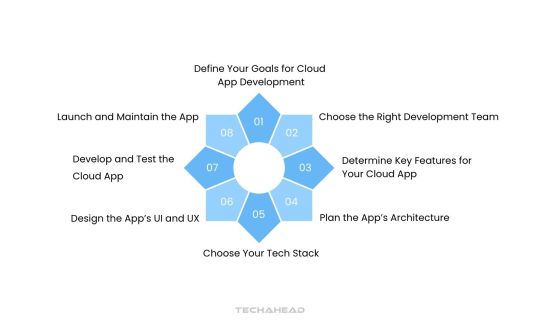
Creating a cloud app can involve web or mobile solutions, with the required technologies varying by solution type. Despite technical differences, the fundamental process in cloud app development follows similar phases to build a robust, user-centered application.
Step 1: Define Your Goals for Cloud App Development
Establishing clear objectives is crucial before development begins. Align all stakeholders on the project’s vision and goals during the discovery phase, helping the team understand the core business needs.
Reasons to consider cloud app development include:
Workflow automation: Streamlining repetitive tasks saves time and resources
Centralized data storage: Access and manage data easily within a single, organized environment.
Enhanced team collaboration: Improve internal communication and ensure seamless data exchanges.
Advanced reporting and analytics: Gain valuable insights to drive data-based decisions.
The discovery phase also allows developers to identify project scope, complexities, potential challenges, and costs. If a swift market entry is critical, a Minimum Viable Product (MVP) may be the best first step.
Step 2: Choose the Right Development Team
Cloud app development requires specialized skills, so selecting the right development team is essential. You can opt for freelancers, in-house talent, or outsource to a software development company.
Choosing a reliable cloud app development partner ensures ongoing support as the app evolves. Here are some questions to assess potential developers:
Can you share similar cloud app projects you have handled?
What platforms and technologies are you skilled in?
How do you prioritize security and scalability in development?
How do you approach cost management for cloud resources?
Can you ensure effective collaboration throughout the project?
A reliable development partner can adapt the app as technology advances and business needs grow.
Step 3: Determine Key Features for Your Cloud App
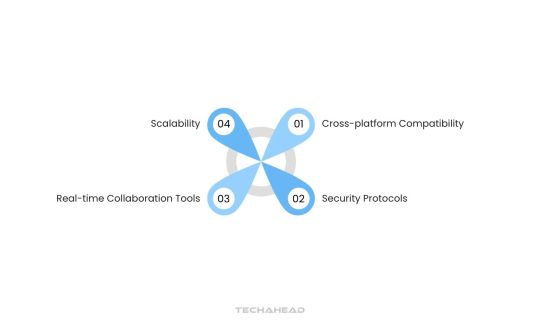
Identify core features that create a user-friendly experience in cloud applications. Essential features include:
Cross-platform compatibility: Allow users to access the app on their preferred devices.
Security protocols: Implement logins and access controls to protect user data.
Real-time collaboration tools: Enable users to work together through features like chat, live comments, and shared documents.
Scalability: Ensure the app can handle increasing users or workload.
Incorporating these features enhances user satisfaction and engagement, setting your app up for success.
Step 4: Plan the App’s Architecture
Your app’s architecture is the backbone of cloud app development, influencing scalability, security, and cost efficiency. Choose an architecture that aligns with your project’s requirements.
Key options include:
Monolithic architecture: A single, interconnected application; easy to develop but challenging to scale.
Microservices architecture: Divides the app into independent services; highly scalable but may face performance trade-offs.
Serverless architecture: Uses event-triggered functions in a serverless environment, ideal for low-maintenance, scalable solutions.
Hybrid architecture: Combines on-premises and cloud resources for high flexibility but may involve integration complexities.
Select an architecture that best aligns with your cloud app development goals. You can also look into this guide on Serverless Vs. Microservices architecture.
Step 5: Choose Your Tech Stack
The technology stack determines how quickly, securely, and effectively the app functions. Different projects require different combinations of programming languages (e.g., Java, Python, Node.js), databases (e.g., MongoDB, Firebase), frameworks (e.g., React, Angular), and containers (e.g., Docker, Kubernetes).
For instance, a Python-based stack offers scalability and maintenance ease, while Ruby on Rails works well for prototyping and collaboration. Choose the right tech stack that aligns with your app’s performance and integration needs.
Step 6: Design the App’s User Interface (UI) and User Experience (UX)
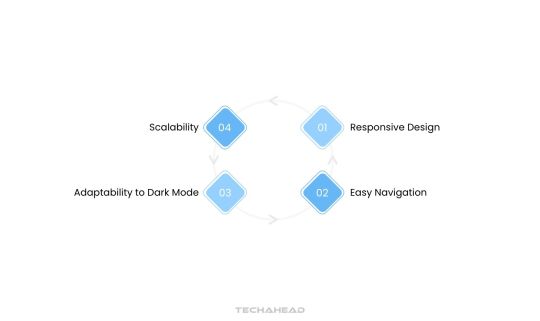
Effective UI/UX design is vital in cloud app development to create intuitive and visually appealing apps. Consider these elements:
Responsive design: Ensure seamless functionality across platforms and screen sizes.
Easy navigation: Users should quickly find what they need with minimal guidance.
Adaptability to dark mode: Offer both light and dark modes to reduce eye strain.
Scalability: Design a UI that accommodates future growth and additional features.
A responsive, intuitive, and adaptable UI makes the app user-friendly and future-proof. You can learn more about the Mobile UI designs as well.
Step 7: Develop and Test the Cloud App
Cloud app development typically uses Agile or DevOps methodologies, depending on project needs and team preferences.
Agile development emphasizes short, iterative development cycles, with regular testing and feedback after each sprint. Agile promotes flexibility, allowing the team to adapt to evolving requirements.
DevOps fosters collaboration across development and operations, with a focus on Continuous Integration/Continuous Delivery (CI/CD) and automation for efficient testing and deployment.
Both approaches streamline development, but the choice depends on team readiness and project goals.
Step 8: Launch and Maintain the App
Successful cloud app development doesn’t end with deployment. Continuous maintenance keeps your app relevant, responsive, and secure. Essential areas include:
Security updates: Regular patches to safeguard user data.
Performance optimization: Keep the app fast and responsive as usage grows.
Scalability adjustments: Ensure the app scales efficiently as demand fluctuates.
Technology updates: Adapt the stack to new versions or libraries.
Ongoing maintenance ensures a secure, scalable, and high-performing cloud app that keeps pace with technological advancements and user expectations.
Benefits of Cloud App Development
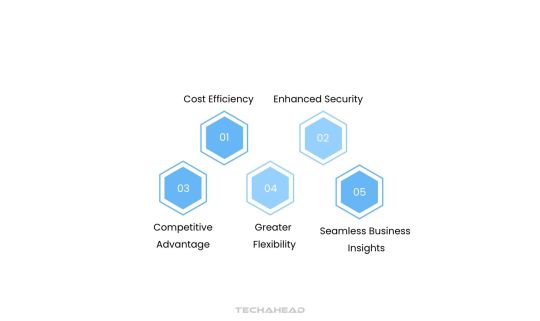
Cost Efficiency
Cloud app development significantly reduces costs by eliminating the need for on-premise infrastructure. With cloud-based applications, businesses only pay for the services they use, making it approximately 40% more affordable for small companies. This pay-as-you-go model means businesses can adjust monthly expenses based on usage, resulting in ongoing cost control.
Unlike traditional hardware, which requires significant upfront investment, cloud solutions offer flexible pricing that can scale with business growth. Additionally, many providers offer cost-saving options, like discounts on long-term contracts for larger enterprises.
You can learn more about the cost of app development.
Enhanced Security
Data security remains a huge priority when it comes to cloud app development. While integrating them, they tend to provide robust protection that safeguards sensitive information. Top cloud-based service providers employ advanced encryption techniques. It all helps in making it harder to get data accessibility for unauthorized users.
Even if there’s an intrusion attempt, encryption ensures data remains protected. Cloud hosting also includes 24/7 monitoring by specialized security teams, often surpassing the reliability of in-house systems. Research shows that 94% of businesses have reported enhanced data security after moving to cloud-based applications, demonstrating its effectiveness in managing data integrity and safety.
Competitive Advantage
Leveraging cloud app development gives companies a significant competitive edge. Cloud services handle infrastructure management, freeing up IT teams to focus on innovation and growth-centric initiatives. With a faster deployment cycle and access to the latest cloud technologies, cloud-enabled companies stay ahead in a rapidly evolving market.
Studies indicate that 77% of organizations find cloud technology helps maintain a competitive advantage. Cloud providers regularly update their offerings, allowing businesses to utilize state-of-the-art tools without needing continual hardware upgrades.
Greater Flexibility
Cloud app development introduces flexibility that in-house servers can’t match, especially in scaling resources. Teams no longer need to worry about storage or bandwidth limitations since cloud infrastructure can easily expand based on demand. This adaptability enables businesses to swiftly respond to changing market needs and to adjust resources during peak times. By outsourcing app development to cloud providers, in-house teams can focus on creating impactful solutions that directly support business objectives, fostering a more agile methodology, and resilient organization.
You can learn more about Offshore Vs. Onshore.
Seamless Business Insights
Current data-driven environment, the insights derived from cloud app development are invaluable. Cloud storage solutions offer powerful analytics tools that allow businesses to process and analyze data effortlessly. With these tools, businesses can gain actionable insights, create detailed reports, and use real-time data to enhance decision-making.
Conclusion
Cloud computing is transformative, future-ready technology that drives business scalability, efficiency, and sustainable growth. Leveraging cloud app development, companies startups or even established enterprises can significantly enhance performance, streamline operations, and cut down on overhead expenses.
Investing in cloud app development services is a strategic step for any business aiming to launch a resilient, next-gen mobile application. Given the technical expertise required for implementing cloud infrastructure in mobile applications, it’s advisable to engage skilled app developers with experience in startup solutions.
Source URL: https://www.techaheadcorp.com/blog/cloud-app-development-reaching-the-value-infection-point/
0 notes
Text
0 notes
Text
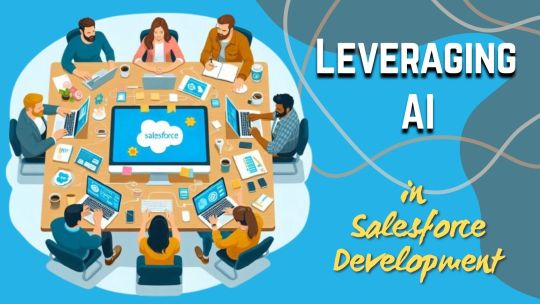
Leveraging AI in Salesforce Development
Artificial Intelligence (AI) is revolutionizing Salesforce development by infusing intelligence into traditional CRM processes. AI allows Salesforce to evolve from a static data management platform into a dynamic, insight-driven system that can predict, recommend, and automate key functions. With AI, Salesforce development is now more about building solutions that are not just reactive but proactive.
Know more at: https://www.cyberswift.com/blog/leveraging-ai-in-salesforce-development/
#generative ai in salesforce#salesforce ai cloud#salesforce einstein gpt#ai-powered crm solutions#bill cipher#salesforce automation with ai#predictive analytics in salesforce#ai-driven customer insights#ai-enhanced salesforce workflows#salesforce lightning and ai integration#chatbots and salesforce crm#salesforce consulting services#salesforce crm solutions#custom salesforce development#salesforce lightning development#salesforce app development#salesforce api integration#salesforce cloud services#salesforce automation solutions#salesforce migration services#salesforce support and maintenance#low-code salesforce development#ai-powered salesforce solutions#iot integration with salesforce#salesforce blockchain integration
1 note
·
View note
Text
#low code crm#non tech teams#crm solution#no code crm#empowering teams#user friendly crm#crm for non tech users
0 notes
Text
How Are Successful Companies Implementing Low-Code/No-Code for Transformative Results?

In Today’s evolving business world, low-code and no-code platforms have become key tools for companies looking to improve their operations. These platforms enable businesses to build applications and automate tasks without needing coding skills. Low-Code Development is a way to create with minimum code, using visual interfaces and drag and drop tools which speeds up development process and reduces the need for expert programming knowledge. Many outstanding companies have implemented Low Code Development to increase their operational efficiency and quickly adapt to market changes.
1. HDFC Bank:

HDFC Bank faced challenges with their customer onboarding process, which was time-consuming and involved multiple manual steps. They needed a more efficient way to onboard new customers and handle documentation. The bank adopted a low-code platform to develop a digital onboarding solution. This application automated the onboarding process, including document collection, verification, and account setup.
The new system reduced the time required to onboard customers, improving overall efficiency and customer satisfaction. By automating manual tasks, HDFC Bank was able to offer a faster and more seamless onboarding experience.
2. Tata Consultancy Services (TCS)

TCS, a major IT services and consulting firm, needed to simplify various internal processes to improve efficiency. They look for a solution that could be developed quickly and adapt to changing requirements. TCS adopted a low-code platform to create several internal applications, including tools for project management and employee onboarding. These applications are designed to work with existing systems and meet specific needs.
The low-code solutions led to improved efficiency, with faster development of applications. This flexibility allowed TCS to respond quickly to internal demands and improve productivity across teams.
3. HCL Technologies

HCL Technologies needed to improve their HR processes, particularly in handling employee requests and managing internal workflows. Their existing systems were inconvenient and inefficient. HCL Technologies implemented a no-code platform to develop HR automation tool. This tool simplified tasks like handling leave requests, performance reviews, and employee queries.
The automation tool greatly improved HR operations. Employees could easily manage their requests through a user-friendly interface, and HR staff spent less time on routine tasks. This helps HR department became more responsive and effective.
4. ICICI Bank

ICICI Bank aimed to improve customer service by providing quicker responses and more efficient handling of customer inquiries. Traditional customer service channels were not meeting the growing demand. The bank adopted a no-code platform to create a customer service chatbot. This chatbot was designed to handle common queries, provide account information, and assist with basic transactions.
The chatbot improved customer service by providing instant responses and reducing the workload on employees. Customers experienced faster resolution of their queries, improving overall customer satisfaction and engagement with the bank.
5. Zomato

Zomato, a leading food delivery and restaurant discovery platform, needed to optimize various internal operations, such as order management and vendor coordination. The existing systems couldn’t keep up with the company’s rapid growth due to their lack of flexibility. Zomato used a low-code platform to create custom applications for handling internal workflows. These applications automated order processing, improved vendor communications and monitor performance metrics.
The new applications improved operational efficiency, reduced manual errors, and facilitated better management of increasing orders and vendor interactions. This allowed Zomato to scale its operations more effectively and support its expanding business.
Benefits of Low Code and No Code Platforms:
Increased Efficiency: Automation and simpler processes makes tasks faster and reduce the need for manual work.
Customer Experience: Faster and more responsive services boost customer satisfaction and engagement.
Flexibility: Fast development and launch help companies quickly adjust to new needs and market changes.
Cost Efficiency: Using fewer IT resources and developing faster help save money.
By using low-code and no-code platforms, companies have transformed their operations, making things more innovative and efficient. As more businesses see how useful these tools are, they will probably become a key part of modern tech solutions. At Aarka Solutions, we’ve used low-code and no-code platforms to make our operations better and more efficient. These tools have helped us innovate quickly and cut down on the need for lots of IT resources. If you’re interested in implementing low-code or no-code solutions for your business, contact us today or Reach out at www.aarkasolutions.com / www.aarkasolutions.in.
#aarka solutions#best software development company#software development#low code development#no code development#low code development platforms#software development trends#latest software development trends#software development 2024
0 notes
Text
Businesses looking to streamline their Power Apps development processes must comprehend the distinction between Model-Driven Apps and Canvas Apps in Microsoft PowerApps. Both app types offer distinct approaches to building applications, with their own sets of advantages depending on the specific use case. Model-driven apps are data-centric and built around the Common Data Service (CDS), making them ideal for applications that require structured data relationships. Users interact with pre-defined forms, views, and dashboards in these apps, which are automatically generated according to the data model. Model-Driven Apps' main benefits are their rapid scalability and smooth integration with other Microsoft products.Businesses that require reliable, data-intensive software for handling intricate procedures like enterprise resource planning (ERP) or customer relationship management (CRM) are especially well-suited for them. Conversely, Canvas Apps offer greater design flexibility.. With Canvas Apps, developers have complete control over the user interface, allowing them to drag and drop various elements to create a highly customized experience. These apps can connect to multiple data sources, from Excel files to SharePoint lists, offering greater adaptability. Canvas Apps are ideal for scenarios where visual customization is paramount and users require more freedom in layout and user interaction. When deciding between the two, businesses should consider the specific needs of their application. Model-driven apps are best suited for scenarios where structured data and complex relationships take center stage. At the same time, Canvas Apps shine in situations where visual design and user experience are a priority. For companies looking to implement these solutions, partnering with a Power Apps consulting firm can provide the expertise needed to choose the right app type based on their development goals. Whether embarking on your first PowerApps project or refining an existing solution, understanding the fundamental differences between these two types of apps can significantly impact your success in Power Apps development.
#powerapps developers#hire powerapps developer#buy power apps#microsoft power apps development#microsoft power platform consulting#microsoft power platform solution#microsoft powerapps consulting services#microsoft powerapps development company#power apps development services#powerapps consulting services#powerapps development company#best microsoft powerapps consulting services#low code app development services#microsoft power apps consulting#microsoft power apps solutions#microsoft powerapps service#microsoft powerapps services#power apps developers#power apps integration#power apps services#top microsoft powerapps consultants#top microsoft powerapps development company
0 notes
Text
Transform your enterprise with low-code technology. Enable effortless innovation and streamline development with intuitive, user-friendly tools
#Agile And DevOps Practices#Cloud Computing Solutions#Conventional Software Development#Enhanced Software Development Processes#Enterprise-Level Solutions#Low-Code Development Platforms
0 notes